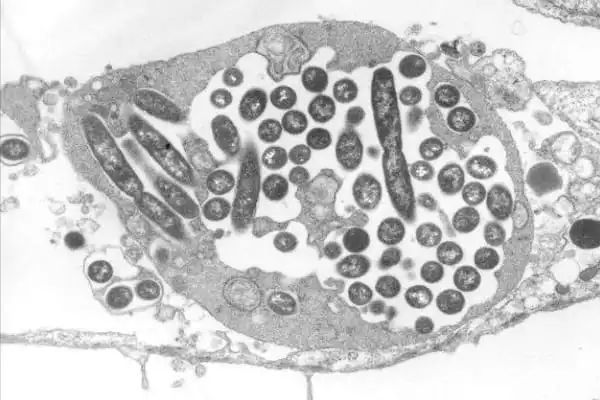In the modern world, we often imagine nature to be red in tooth and claw, a constant struggle for survival between predator and prey. Life on the early Earth, prior to the evolution of complex plants and animals, appears peaceful in comparison. There are only single-celled organisms floating around in the water, gathering energy from the Sun. However, it turns out that the struggle for survival begins much earlier than most of us realize. Predatory bacteria attacked our distant ancestors, early eukaryotes, almost from the beginning.
Uppsala University researchers discovered that legionella bacteria infected eukaryotic cells as early as two billion years ago. It happened soon after eukaryotes started eating bacteria. These findings, described in a new study published in Molecular Biology and Evolution, are also relevant in the debate over whether mitochondria or phagocytosis came first.
“Our study can help us understand how harmful bacteria emerge and how complex cells evolved from simpler cells,” says Lionel Guy, associate professor of evolutionary microbiology at the Department of Medical Biochemistry and Microbiology and the study’s principal investigator.
We discovered that the ancestor of the entire group lived about two billion years ago, when eukaryotes were still evolving from simpler cells to the complex cell structure they have now.
Andrei Guliaev
Ancestors of legionella bacteria had the ability to avoid being digested by eukaryotes two billion years ago. Instead, they started multiplying using eukaryotic cells, which are complex cells with a nucleus that make up amoebas, fungi, and humans.
The legionella bacterium, which causes Legionnaires’ disease, is a member of the Legionellales, a large group of bacteria. Legionellales bacteria can infect any eukaryotic host, including amoebas, insects, and our own cells.
“We discovered that the ancestor of the entire group lived about two billion years ago, when eukaryotes were still evolving from simpler cells to the complex cell structure they have now,” says Andrei Guliaev, a researcher at the Department of Medical Biochemistry and Microbiology. “We believe Legionellales were among the first microorganisms to infect eukaryotic cells.”
The first step in a legionella bacteria infection is for a eukaryotic host, such as an amoeba, to bring the bacterium into its cell via phagocytosis. The amoeba’s next step would be to digest the bacterium and use its components as an energy source. However, legionella bacteria have molecular tools that prevent them from being digested and allow them to multiply by using the amoeba as an energy source.
The researchers demonstrate in the study that all Legionellales have the same molecular tools as legionella. This suggests that the ability to infect eukaryotes existed in the ancestor of all Legionellales. This means that phagocytosis is at least as old as Legionellales — two billion years old — when eukaryotes were in their early stages of evolution.

This has implications for the chicken-or-egg debate in evolutionary biology about how eukaryotes evolved. Which came first, the chicken or the egg? Was it the mitochondria, which evolved from another group of bacteria and became our cells’ own energy factories? Or was it phagocytosis, which is thought to be necessary for mitochondrial absorption but is very energy-intensive?
“According to some researchers, mitochondria are required to provide enough energy for phagocytosis to function. However, our findings suggest that phagocytosis evolved first, two billion years ago, and mitochondria evolved later” Lionel Guy says.
It’s unclear where legionellales came from, but it’s likely it didn’t exist, or at least wasn’t attacking cells, before eukaryotes appeared. There are numerous legionellale lineages today, all of which attack eukaryotes. That would most likely not be possible if they were present and behaving in the same manner as before.
“When they appeared, they would all have had to evolve a way to get into eukaryotes.” That is highly unlikely because they use the same tools. It would necessitate a great deal of convergent evolution. “It’s not impossible, but it’s unlikely,” Guy said.
Whatever their strategy was, it was a huge success. Modern diseases such as Legionnaires are only the most recent battle in a war that has raged for two billion years. But things could change. “There is a wide range of ecological types.” “Some of them are purely parasitic, while others are mutualistic, and there are a lot of transitions within those groups,” Guy explained. “How could we tame bacteria?” “How do we transform them from parasitic to helpful?”
Studying ancient bacteria such as legionellales not only provides a clearer picture of how life evolved on our planet, but it may also provide us with the tools we need to turn the tide of the war and make allies of our smallest adversaries.





